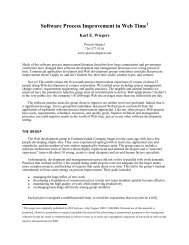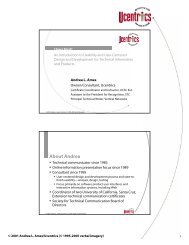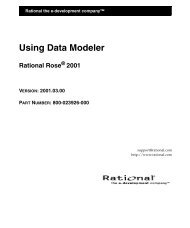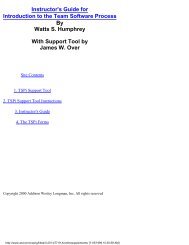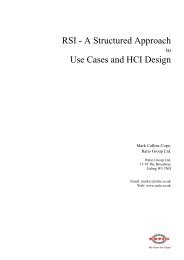Use Case Management with Rational Rose and Rational ... - IBM
Use Case Management with Rational Rose and Rational ... - IBM
Use Case Management with Rational Rose and Rational ... - IBM
You also want an ePaper? Increase the reach of your titles
YUMPU automatically turns print PDFs into web optimized ePapers that Google loves.
<strong>Use</strong> <strong>Case</strong> <strong>Management</strong><br />
<strong>with</strong> <strong>Rational</strong> <strong>Rose</strong> <strong>and</strong><br />
<strong>Rational</strong> RequisitePro<br />
© 2001 by <strong>Rational</strong> Software Corporation.<br />
All Rights Reserved.<br />
A <strong>Rational</strong> Software White Paper
Table of Contents<br />
Introduction............................................................................................................................................................... 1<br />
Why Manage Requirements?................................................................................................................................... 1<br />
Why Manage <strong>Use</strong> <strong>Case</strong>s?.......................................................................................................................................... 1<br />
Setting up the Integration......................................................................................................................................... 1<br />
Requirements <strong>Management</strong> Capabilities in <strong>Rose</strong>................................................................................................... 2<br />
<strong>Use</strong> <strong>Case</strong> Document ................................................................................................................................................ 2<br />
Requirements Properties ......................................................................................................................................... 3<br />
Benefits of Managing <strong>Use</strong> <strong>Case</strong>s .............................................................................................................................. 4<br />
Summary.................................................................................................................................................................... 6
Introduction<br />
1. How do you organize your use cases?<br />
2. Can you tell in which release a particular use case is implemented?<br />
3. How do you know that the entire system functionality is tested?<br />
4. Which tests are affected by a change in a use case?<br />
If the inability to answer these questions has caused you frustration, schedule setbacks, or the delivery of<br />
products that have missed the mark, read on.<br />
Integrated <strong>Use</strong> <strong>Case</strong> <strong>Management</strong> enhances <strong>Rational</strong> <strong>Rose</strong> use-case modeling <strong>with</strong> powerful requirements<br />
management capabilities. By extending use cases beyond diagrams <strong>with</strong> sortable attributes, documents, <strong>and</strong><br />
traceability, Integrated <strong>Use</strong> <strong>Case</strong> <strong>Management</strong> helps manage large numbers of use cases across your team.<br />
This is the tightest <strong>and</strong> most robust integration in the market between a visual modeling tool <strong>and</strong> a<br />
requirements management tool.<br />
Why Manage Requirements?<br />
Requirements management is a systematic approach to finding, documenting, <strong>and</strong> managing requirements.<br />
Without it, more than two-thirds of projects end up missing user needs, are late or over budget (St<strong>and</strong>ish<br />
Group, CHAOS Report available at www.st<strong>and</strong>ishgroup.com ). Why so many? Primarily because managing<br />
requirements is about managing change – <strong>and</strong> managing change is hard. Plus change is pervasive. We live<br />
in a dynamic world: customers change their minds, competitors come up <strong>with</strong> better solutions before we<br />
deliver ours, the business environment changes. Being open to this changing environment is a good thing,<br />
but it can bog you down. Change in itself isn’t bad. The evil beast is uncontrolled change – change whose<br />
impact is not measured before it happens. By managing requirements you are more likely to deliver a timely<br />
solution that solves your customers’ real problems.<br />
Why Manage <strong>Use</strong> <strong>Case</strong>s?<br />
By providing a user’s view of what the system should do, use cases are requirements. As such, use cases<br />
should participate in the management of all system requirements. Most software projects have numerous use<br />
cases, all of which have different priorities <strong>and</strong> dependencies – just like any other requirement. For<br />
example, a use case describing the processing of an order on the Web might stem from the business need of<br />
generating more revenue through the Web. By establishing a tangible dependency between the use case <strong>and</strong><br />
its business need, you can better respond to change affecting either of these requirements. And prioritizing<br />
the importance of implementing this use case versus another helps you know where to start.<br />
Managing use cases along <strong>with</strong> all other requirements is key to underst<strong>and</strong>ing the state of your project <strong>and</strong><br />
better enables you to deliver the right system. The value of Integrated <strong>Use</strong> <strong>Case</strong> <strong>Management</strong> is that it<br />
seamlessly integrates uses cases <strong>with</strong> your requirements information.<br />
Setting up the Integration<br />
Integrated <strong>Use</strong> <strong>Case</strong> <strong>Management</strong> begins by associating your <strong>Rational</strong> <strong>Rose</strong> model <strong>with</strong> a <strong>Rational</strong><br />
RequisitePro project. This association provides the context for selecting use-case document templates <strong>and</strong><br />
use-case attributes from the <strong>Rose</strong> environment. You can establish this association either at the model level<br />
or at the package level, where each package may be associated <strong>with</strong> its own RequisitePro project. The<br />
package association lends itself to large software projects that might use either multiple RequisitePro<br />
projects (typically one per subsystem) or different use case document templates (for business use cases vs.<br />
system use cases).<br />
1
A <strong>Rational</strong> RequisitePro project consists of a number of Microsoft Word documents <strong>and</strong> a database<br />
(Microsoft Access, Microsoft SQL Server or Oracle) to organize the requirement information. <strong>Use</strong> case<br />
documents in RequisitePro contain use-case textual descriptions, just like what you may be writing today.<br />
Requirements in these documents are linked to a database that stores additional requirement information,<br />
such as attributes, traceability links, versioning, change history, project security <strong>and</strong> more. From the<br />
RequisitePro database, you can query the requirement information to check coverage <strong>and</strong> measure the<br />
impact of change. You can also easily navigate to the RequisitePro Word environment <strong>and</strong> back to <strong>Rose</strong>.<br />
Requirements <strong>Management</strong> Capabilities in <strong>Rational</strong> <strong>Rose</strong><br />
Requirement management capabilities are visible from the st<strong>and</strong>ard shortcut menu in the <strong>Rational</strong> <strong>Rose</strong><br />
browser –right-click on a use case in <strong>Rose</strong> to view the new use-case menu options (see Figure 1). They<br />
include:<br />
• <strong>Use</strong> <strong>Case</strong> Document to create a new use-case document or associate the use case <strong>with</strong> an existing<br />
RequisitePro use-case document<br />
• Requirement Properties to view <strong>and</strong> edit attributes <strong>and</strong> traceability links to the use case<br />
• View RequisitePro Association to view the <strong>Rational</strong> RequisitePro context for that use case (the<br />
associated use case document template <strong>and</strong> use case attributes – set via a requirement “type”)<br />
Lets look at these capabilities in more detail.<br />
Figure 1: New options on the use-case shortcut menu in <strong>Rose</strong><br />
<strong>Use</strong> <strong>Case</strong> Document<br />
If you are an existing <strong>Rose</strong> user, you may be writing use-case documents <strong>and</strong> attaching them to your usecase<br />
model via the <strong>Rose</strong> External File property. The new Integrated <strong>Use</strong> <strong>Case</strong> <strong>Management</strong> capability goes<br />
beyond simply attaching a file to a <strong>Rose</strong> use case. Because the documents attached to your use cases are<br />
<strong>Rational</strong> RequisitePro documents, you benefit from the following advantages:<br />
• <strong>Use</strong> case documents are based on proven use-case document templates.<br />
Integrated <strong>Use</strong> <strong>Case</strong> <strong>Management</strong> provides <strong>Rational</strong> Unified Process use case templates. These<br />
templates contain informative guidelines as well as use case formatting, saving you time <strong>and</strong><br />
providing consistency from document to document.<br />
2
• Requirement text is clearly marked.<br />
Requirement text is visually differentiated from additional descriptive information in the document<br />
(See Figure 2.). This makes it easier to “see the trees in the forest.”<br />
Figure 2: Requirements in a <strong>Rational</strong> RequisitePro document<br />
• Any modification to use case documents is automatically tracked.<br />
Information about who modifies what, when, <strong>and</strong> why is stored in the <strong>Rational</strong> RequisitePro<br />
database. These revisions help you gain control of use case changes.<br />
• Requirements in use case documents can be linked to other requirements they may relate to.<br />
By tracing use cases to business requirements, feature-level requirements, tests, or even other use<br />
cases you can more easily measure the impact of change on related requirements <strong>and</strong> verify<br />
coverage.<br />
To associate a use case document <strong>with</strong> a <strong>Rose</strong> use case, right-click on the use case in the <strong>Rose</strong><br />
browser, <strong>and</strong> select <strong>Use</strong> <strong>Case</strong> DocumentNew from the shortcut menu. The RequisitePro Word<br />
environment is launched <strong>and</strong> your template-based document is displayed, ready for editing. You<br />
can also associate an existing RequisitePro document to a <strong>Rose</strong> use case by using the <strong>Use</strong> <strong>Case</strong><br />
DocumentAssociate menu item.<br />
Requirements Properties<br />
The second new addition to the use-case shortcut menu is “Requirements Properties.” Requirements, <strong>and</strong><br />
similarly use cases, are not just text. They have additional properties, such as attributes, traceability links,<br />
revision history, <strong>and</strong> particularly for use cases – diagrams.<br />
3
Attributes help manage scope. Especially helpful in iterative development, attributes provide an easy way<br />
to scope manage each iteration of your project. They make the process of deciding the use cases to<br />
implement in a particular release more objective. Too often organizations decide which use cases to<br />
implement based on personal agendas, emotions, or pet peeves. Poor decisions made early carry through to<br />
implementation <strong>and</strong> are more costly to change the farther the project gets in its lifecycle. Attributes provide<br />
a simple way to assign non-emotional weight to use cases <strong>and</strong> requirements alike.<br />
Traceability helps measure the impact of change <strong>and</strong> ensure requirements coverage. For instance, if a<br />
business need changes, what use cases might be impacted? By establishing traceability links, you can query<br />
the requirements to answer questions like “Are all business needs implemented at the use case level?” or<br />
“Are there test requirements for all the use cases?”<br />
(Note for <strong>Rational</strong> Unified Process users: you may want to review the Traceability Strategies for<br />
Requirements <strong>Management</strong> With <strong>Use</strong> <strong>Case</strong>s white paper available in RUP. The paper outlines various<br />
traceability approaches, depending on your needs.)<br />
Revisions helps you track who changes what, when <strong>and</strong> why, to provide an audit trail of requirement<br />
changes. This helps you measure the stability of requirements <strong>and</strong> concentrate on more stable requirements<br />
first, inherently diminishing the amount of change.<br />
To set use case attributes <strong>and</strong> relationships in <strong>Rational</strong> <strong>Rose</strong>, right-click on the use case in the <strong>Rose</strong><br />
browser, <strong>and</strong> select Requirement PropertiesOpen from the shortcut menu. In the dialog box (see Figure<br />
3), click the Attributes tab, <strong>and</strong> set attribute values. Note that you can change the out-of-the-box use case<br />
attributes <strong>and</strong> their values in the RequisitePro project associated <strong>with</strong> your model. From this same dialog<br />
box, click the Traceability tab to establish traceability between the use case <strong>and</strong> other requirements.<br />
Figure 3: Viewing <strong>and</strong> editing use case requirement properties in Ratioanl <strong>Rose</strong><br />
Benefits of Managing <strong>Use</strong> <strong>Case</strong>s<br />
Once you’ve attached a use case document, or assigned requirement properties to a use case in <strong>Rational</strong><br />
<strong>Rose</strong>, the use case is part of your requirement set in RequisitePro. As such you can use all <strong>Rational</strong><br />
RequisitePro capabilities to sort your use cases (by priority, by iteration number, etc.), to query on specific<br />
use cases (only the use cases planned for the next iteration), <strong>and</strong> even produce requirements metrics.<br />
4
Using an Attribute Matrix View in <strong>Rational</strong> RequisitePro (see Figure 4), you can view all or a select subset<br />
of use cases <strong>and</strong> their respective attributes. This helps you organize the use case information answering the<br />
first question at the beginning of this article: How do you organize your use cases? You can run queries to<br />
determine which use cases are assigned to which designer, how difficult they are to implement, or in which<br />
release they should be implemented (Can you tell in which release a particular use case is implemented?).<br />
Figure 4: <strong>Use</strong> case Attribute Matrix View in <strong>Rational</strong> RequisitePro<br />
Once you have selected the use cases to be implemented in the next iteration, you should verify that test<br />
requirements are traced to use cases ensuring that all the functionality will be tested. The Traceability<br />
Matrix View in Figure 5 shows the relationships established between use cases <strong>and</strong> test cases. Using<br />
Traceability Matrices, you can query on use cases not yet traced to test requirements (answering the<br />
question How do you know that the entire system functionality is tested?). Additionally, testers can query<br />
test requirements potentially impacted by modifications in use cases ensuring that they’re testing the latest<br />
functionality. A suspect link (red slashed arrow in Figure 5) indicates that test case TC1.2 may need to be<br />
revisited due to a change in use case UC1.3. Querying on suspect links answers our last question, which<br />
tests are affected by a change in a use case?<br />
5
Summary<br />
Figure 5: Traceability relationships between use cases <strong>and</strong> test cases in <strong>Rational</strong> RequisitePro<br />
Integrated <strong>Use</strong> <strong>Case</strong> <strong>Management</strong> extends use cases <strong>with</strong> requirement information. This benefits the<br />
<strong>Rational</strong> <strong>Rose</strong> user by establishing a real-time window to modify use case attributes, traceability <strong>and</strong> view<br />
revision history from <strong>Rose</strong>. And the <strong>Rational</strong> RequisitePro use case document is just a click away.<br />
Integrated <strong>Use</strong> <strong>Case</strong> <strong>Management</strong> provides requirements managers more accurate <strong>and</strong> timely information to<br />
work <strong>with</strong> because that information is available from the <strong>Rose</strong> users’ fingertips. By managing use cases in<br />
conjunction <strong>with</strong> other requirements your project can be better scope managed, change can be controlled<br />
<strong>and</strong> coverage can be verified. In short, Integrated <strong>Use</strong> <strong>Case</strong> <strong>Management</strong> helps ensure that you are<br />
implementing the functionality that was agreed upon, <strong>and</strong> that this functionality will be fully tested.<br />
6
Dual Headquarters:<br />
<strong>Rational</strong> Software<br />
18880 Homestead Road<br />
Cupertino, CA 95014<br />
Tel: (408) 863-9900<br />
<strong>Rational</strong> Software<br />
20 Maguire Rd<br />
Lexington, MA 02421<br />
Tel: (781) 676-2400<br />
Toll-free: (800) 728-1212<br />
Tel: (408) 863-9900<br />
Fax: (408) 863-4120<br />
E-mail: info@rational.com<br />
Web: www.rational.com<br />
For International Locations: www.rational.com/worldwide<br />
<strong>Rational</strong>, <strong>Rational</strong> logo, <strong>Rational</strong> the e-development company, <strong>Rational</strong> RequisitePro <strong>and</strong> <strong>Rational</strong> <strong>Rose</strong><br />
among others are trademarks or registered trademarks of <strong>Rational</strong> Software Corporation. References to<br />
other companies <strong>and</strong> their products use trademarks owned by the respective companies <strong>and</strong> are for reference<br />
purposes only. ALL RIGHTS RESERVED. Made in the U.S.A.<br />
© Copyright 2001 by <strong>Rational</strong> Software Corporation.<br />
Subject to change <strong>with</strong>out notice.



